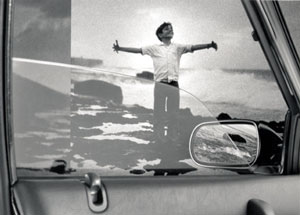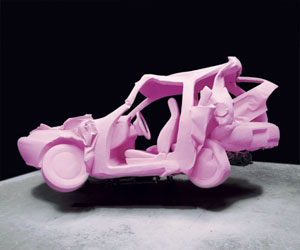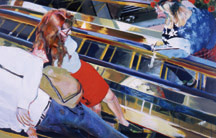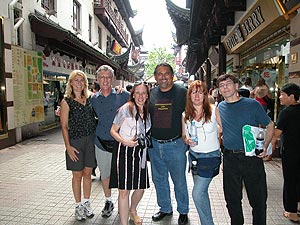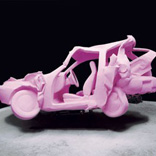They could be sister cities, Shanghai and Houston. Steamy weather provides a languid backdrop for a Jetson-esque cityscape punctuated with noisy knots of traffic. People from elsewhere move here in droves (of Shanghai's 22 million people, 95% are not born there).
To say that Shanghai is a city of contrasts is to begin a richly evocative mantra. To stand anywhere in this fabulous city is to witness China's past and the world's future. It's a 21st -century El Dorado, drawing speculators of all sorts with the promise of vast, quick wealth. It's the most populous city in the most populous country on Earth. It's sultry, sprawling, booming, beautiful and terrible. In some ways, it's not that different from Houston.
They could be sister cities, Shanghai and Houston. Steamy weather provides a languid backdrop for a Jetson-esque cityscape punctuated with noisy knots of traffic. People from elsewhere move here in droves (of Shanghai's 22 million people, 95% are not born there). Rampant wealth coexists with the humblest of means (the average annual wage for a Shanghainese is $1,200 US). Culture and commerce manage a symbiosis.
A Houston/Shanghai cultural exchange makes sense. But wouldn't such a massive undertaking be fraught with difficulty? After all, China is still a communist country and Shanghai is its dazzling anomaly.
Enter the dragon. The brainchild of art-loving sinophiles Margarida and Penn Williamson, Houston Contemporary Art, a show of 40 Houston artists, is an amazing accomplishment. Held this summer at the Shanghai Art Museum (home to the Shanghai Biennial) and co-curated by Gus Kopriva, Redbud Gallery's prescient wizard of other foreign shows (in Cuba and Leipzig), and Shanghai's driven curator/critic Christopher Zhu, this groundbreaking exhibition came together in only a few days' time.
Gus had been toying with the idea of a show in China for many months. When a July slot suddenly opened at the impressive Shanghai Art Museum, the call went out to artists in early May. The works were selected practically overnight. Weeks later the crated art was on a slow boat to China. A hefty catalogue was also in the works. All this was privately funded by American and Chinese benefactors, and unfolded in record time.
All this, still, was not enough. While a handful of the artists funded their own passage to China, Margarida Williamson, vivacious and relentless, raised still more funds to fly a few more artists to join the Shanghai contingent. Christopher arranged for pleasant apartments for each of us in a teeming, residential part of the city. Artists Suzanne Banning, Tim Glover, Brian Portman, Jesus Moroles and myself, along with Paper City's Catherine Anspon, converged on Shanghai, joining Margarida a few days before the opening. The others, Gus and Sharon Kopriva, Kelly Alison, Michael Roque Collins, Dixie Friend Gay, Wayne Gilbert and Angelbert Metoyer, arriving later still, stayed at the storied hotels near the Bund, a district famous for its Euro-influenced architecture. The art, too, had just arrived and was waiting in port.
With the work down at the docks and the 13,000 sq. ft gallery in de-installation mode, we had time to see Shanghai. Taxis were the preferred mode of transport — quick, cheap and efficient. Whether seen through a cab's window or on foot, the jaw-dropping contrasts of Shanghai revealed themselves. Tiny kittens sold curbside in cages on ancient narrow streets a stone's throw from a Maserati dealership, a palace of steel and glass. Dazzling futuristic towers spontaneously generated amid crumbling '50s era facades (one-fourth of the world's building cranes are here). Harmony and its opposite bombard the eye. This is the land of tranquil lotus ponds, gigantic jewel-like broadcast towers, incredible museums and an ancient Ming Dynasty teahouse with a big photo of Bill and Hilary at its entrance. This is home to vast pedestrian malls, narrow 'women's streets' designed for those whose compulsory bound feet made them topple-prone (Mao banned the 1,000-year-old practice of foot binding about 100 years ago), imitations (oh, those fake Fendis) and innovations (the Three Gorges Dam, an engineering marvel on the nearby Yangtse River, has, among many things, the potential to actually slow the Earth's rotation).
The food, celebrated as one of the world's three most innovative cuisines (others being French and Mexican), runs to the extreme: Buddhist temple food consisting of tofu artfully construed to resemble all sorts of meats, including BBQ duck; Shanghai's famous broth-filled dumplings (famous for scorching many an eager eater's lips); '1,000-year-old tofu,' a fermented bean curd unappealing to quite possibly everyone; small food animals beautifully served on a platter with head still intact; and delicate, fragrant teas made from carefully tied bouquets of leaves and stunning tiny flowers. As for the Western food chains, they're here everywhere, the same but different. The latest news was that Krispy Kreme was making its entrance, despite claims that the donuts might be too sweet for the Chinese palate.
One thing, though: Shanghai is not as crowded or smog-bound or workaholic as you might expect. There's no cheek-by-jowl, surgical mask-wearing throng crushing everything in its bicycle-riding wake. The city is full of the young and fashionable enjoying la dolce vita. Of course, bicyclists and cars on the verge of a crash are everywhere (some of the worst driving ever is here), and pedestrians crowd disconcertingly close when waiting for traffic to stop. You are well warned to use a hand purifier and not to drink the water or mention certain political 'sensitivities.' But the overwhelming and buoyant sense is that China is the next world power and its epicenter is Shanghai.
As visitors and therefore guests of the Shanghai art community, we were treated with incredible generosity. The day before the show's opening, Christopher arranged for our group to visit Xi Tang, an ancient and stunningly picturesque canal town. A book we were given cheerfully stated that "the people of Xi Tang like to drink a little bit of wine, constantly." While I saw no evidence of this endless wine consumption, there was so much else. There were beautiful gardens designed to thwart demons and bring luck. There were cormorants trained to fish for their owners in the scenic river. As it has for 1,000 years, the river serves the people living on its banks as a provider of food and transport and a place for bathing, washing dishes and doing laundry. It was sweltering. We discovered the subtle pleasures of a hand fan. The tour ended with an impressive feast of traditional dishes, like the delicious Ma Bo doufou: tofu cooked with a spicy meat sauce. A man and woman shyly appeared with ancient musical instruments and sang beautifully and poignantly.
That night a few of us continued on to the Shanghai Art Museum to check up on the installation. We had heard the rumors: someone's work was missing, some of it still hadn't been installed, the pedestals were hideous, there were problems with the museum's lighting policy, and on and on and on. Fortunately, all the stuff was there and for the most part in place. Everyone did what we could to help out. The lighting problem was still an issue by 10 pm when Christopher tactfully sent us home.
The next day's opening of Houston Contemporary Art was impressive. It was crowded, very grand and very official. But the exhibition, the work in those lofty galleries, looked fantastic. Christopher and his crew had worked through the night to light the show brilliantly. The show itself, a generous, inclusive sampling of work being made in Houston, was a magical thing to behold. And there was the catalogue, a stunning 280-page, hardbound, full-color book with essays by Gus Kopriva, Christopher Zhu, Alison de Lima Greene and Patricia Johnson. The opening was followed by dinner on the museum's rooftop terrace. It was a beautiful, humid night and the view of the surrounding skyscrapers was spectacular.
The fact that all this coalesced so quickly and successfully is a testament to the vision and determination of its organizers, who were tireless in their dedication to this project. It paid off. Around 20,000 visitors a week attended the exhibition, causing the beleaguered security staff to complain of their inability to control the crowds.
Our Chinese hosts gave us and this show their full attention. They held press conferences and tours, and introduced us to some of Shanghai's artists and art media. We were interviewed, photographed, documented on video and, of course, treated to feast after feast. Were we spoiled? Were we converted? Yes and yes. This was no ordinary show of artwork. It was a rare opportunity to open a small channel between two vastly different yet similar worlds and make connections. It's a momentous event that will be complete when Houston extends its generosity to the artists of Shanghai someday soon.
Images courtesy the artists.
Magdalen Celestino is an artist currently living and working in Houston.


